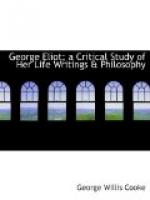One who has been permitted to read the letters of Marian Evans written to this aunt, has given the following account of them, which throws much light on her religious attitude at this period: “Most of the epistles are addressed to my ‘dear uncle and aunt,’ and all reveal George Eliot’s great talents. The style is elegant and graceful, and the letters abound in beautiful metaphor; but their most striking characteristic is the religious tinge that pervades them all. Nearly every line denotes that George Eliot was an earnest biblical student, and that she was, especially in the years 1839 and 1840, very anxious about her spiritual condition. In one of these letters, written from Griff to Elizabeth Evans, in 1839, she says she is living in a dry and thirsty land, and that she is looking forward with pleasure to a visit to Wirksworth, and likens her aunt’s companionship and counsel to a spring of pure water, acceptable to her as is the well dug for the traveller in the desert. That the most affectionate and loving relationship existed between the eminent author and Mrs. Elizabeth Evans, is apparent from this correspondence. The inmost secrets of George Eliot’s heart are laid bare in these letters to the famous Methodist preacher, who was at that time her dearest friend. She is ever asking for advice and spiritual guidance, and confesses her faults with a candor that is rendered additionally attractive by reason of the polished language in which it is clothed. When quite a girl, George Eliot was known as pious and clever; and in the letters she wrote in 1839, when she was twenty years old, the cleverness has grown and expanded, although she is not so sure about her piety. She says that ‘unstable




